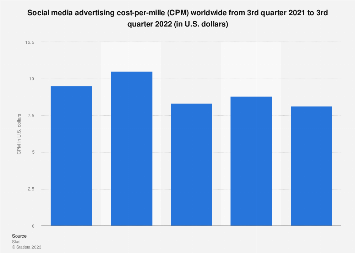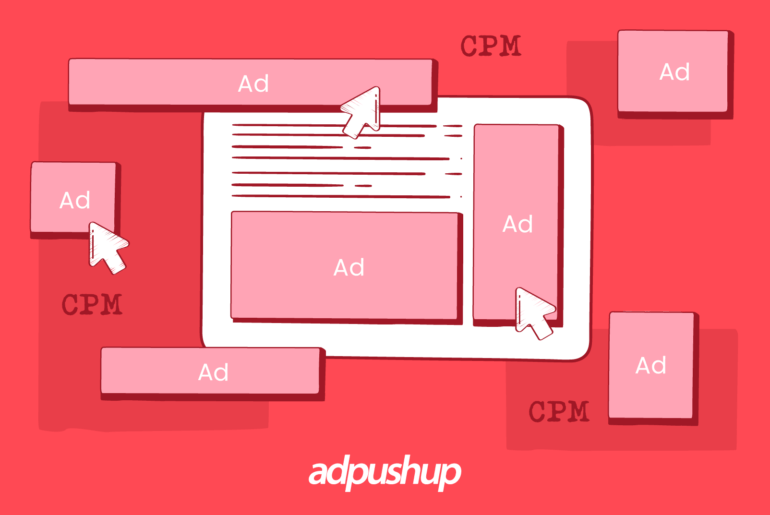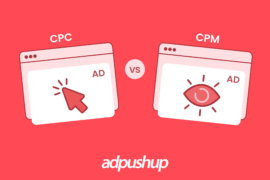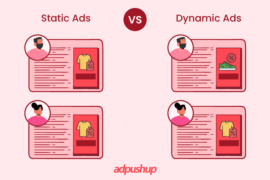Wondering what is CPM? We’ve got you! In this guide, we cover the nitty-gritty details of CPM, why it matters, and how it can help maximise your ad revenue.
The digital world is evolving at a fast pace, and publishers relying on ad revenue must keep up with it and track the metrics that matter. One of those metrics is CPM. While CPM is a familiar term for marketers, a deeper understanding of its nitty-gritty can be incredibly beneficial for publishers and advertisers.
Wondering why is it so important? This is because the higher the CPM publishers will command, the more revenue they will generate.
Without further ado, let’s dive right into the heart of the matter and first understand what is CPM in the advertising industry.
What is CPM? (CPM Meaning)
CPM stands for cost per thousand impressions, which is a metric used to measure the cost of displaying an ad to 1,000 viewers. It’s calculated by dividing the total cost of the ad campaign by the number of impressions and then multiplying the result by 1,000.
Let’s take a more detailed look at CPM calculation.
How to Calculate CPM?
CPM = (Total Cost of the Campaign / Number of Impressions) x 1,000
For example, if an advertiser spends $1,000 on a campaign that generates 100,000 impressions, the CPM would be $10:
CPM = ($1,000 / 100,000) x 1,000 = $10
Why Does CPM Matter?
CPM is an essential metric for publishers to understand because it helps them determine how much revenue they can generate from their advertising inventory. Likewise, Advertisers also need to know the CPM rate of different ad placements and formats so that they can make an informed decision about where to place their ads.
It is widely used in online advertising and is often used in conjunction with other metrics, such as click-through rate (CTR) and conversion rate, to measure the success of an ad campaign. By tracking CPM, publishers, and advertisers can adjust their strategies and optimize their revenue and ROI.
Wondering what is your CPM? The formula for calculating CPM is as follows:
What is a Good CPM?
Giving an exact number is not possible here, as the CPM can be subjective for different publishers and advertisers. Instead, it is much easier to calculate the impact of RPM (Revenue Per Mile), on ROI to find out the effectiveness of a campaign.
💡RPM (Revenue Per Mile) is a revenue generated by publishers per thousand impressions.
Additionaly, if you operate in a less competitive industry, a CPM rate of $5 will be considered good. But, if it’s a competitive industry, a CPM rate of somewhere around between $10 will be considered good.
On a side note, lower CPM doesn’t always mean a positive indication as it represents the degrading quality of the ad inventory. Similarly, a higher CPM is not a positive indication as well because it will result in several unsold ad inventories. It’s because the higher the CPM, the more expensive it will be for the advertisers to buy publishers’ ad inventory.
Check Here: Best CPM Ad Networks For Publishers (2023 Update)
How CPM Rates Vary Across Different Ad Formats: CPM Examples
To help you understand how it works in the real world, here are some examples of how it’s used in online advertising:
Display Ads
A website that displays banner ads charges a CPM rate to advertisers based on the number of impressions ads receive on the site.
Video Ads
A publisher that displays video ads on their site may charge a higher CPM rate than a site that only displays banner ads. It is because video ads typically have a higher production cost and are proven to be more engaging.
Social Media Ads
Platforms like Facebook and Twitter charge advertisers a CPM rate based on the number of ad impressions received in users’ feeds. The cost-per-mille of advertising on social media was 8.15 U.S. dollars in the third quarter of 2022.

Now that we know what is cpm in marketing and its significance, let’s have a look at some of its benefits.
Top 3 Benefits of CPM Metric in Online Advertising
1. An Affordable Option
CPM advertising only involves the cost of impressions rather than clicks or conversions. Hence, it comes up with a much more affordable option when compared with CPA (Cost Per Acquisition) or calculated CPC.
2. Boosted Brand Visibility
CPM campaigns are effective in boosting brand awareness and visibility when you’re targeting a wider audience base. Considering the lower cost of this metric, you can invest more in CPM marketing and even consider it for a newly launched product or service.
3. You Get Valuable Data and Metrics
CPM campaigns allow you to analyze how good your ads are. With apt information, you can track ad impressions, clicks, and other performance metrics.
Disadvantages of Using CPM
After going through all the positives, it’s better to get familiarized with a few negative aspects of using CPM. There are not so many drawbacks, but as we’re getting started, publishers often face issues due to the type of traffic CPM provides.
You will have no idea where your ad is being displayed. The ads may reach the right audience or an audience that has no interest. To be precise, CPM offers impressions, which show that people are able to see the ad, but it won’t show any clicks or conversions.
Moreover, there’s always a risk of advertising fraud. It is mostly in cases where the number of impressions on a web page is increased using unethical strategies so that the companies have to pay a higher price.
What are The Factors Influencing CPM?
Several factors can influence CPM rates, and understanding these factors can help publishers optimize their advertising strategies to increase their revenue. Some key factors that can influence CPM rates include:
1. Audience Demographics
One of the primary factors that can impact CPM rates is the audience’s demographics. Advertisers are willing to pay more for ads that target specific demographics that are more likely to engage with their ads or purchase their products. For example, ads that target a higher income bracket may have a higher CPM rate than ads that target a lower-income audience.
2. Ad Placement
The ad placement can also impact its CPM rate. Ads placed in more visible and prominent positions, such as above the fold or on the homepage, tend to have higher CPM rates than ads placed in less visible locations. Publishers can optimize their ad placement by conducting A/B testing to determine which ad placements generate the highest CPM rates.
3. Ad Format
Different ad formats attract different costs. Rich media ads, such as video or interactive ads, tend to have higher CPM rates than standard banner ads. Publishers can optimize their ad format by offering a range of ad formats and testing which formats generate the highest CPM rates.
4. Seasonality
Seasonality can also play a crucial role in cost-per-mile rates.

For example, during the holiday season, advertisers tend to increase their spending on advertising, which can drive up CPM rates. Similarly, CPM rates may decrease during slower seasons, especially after Q4, as consumer spending slows down.
5. Competition
The level of competition in the advertising market can also impact CPM rates. When there is more competition for ad space, advertisers may be willing to pay more to secure their ads in high-value placements, which can increase CPM rates.
That said, let’s take a look at a few of the practices one can follow to improve their CPM.
Top Practices for Improving CPM
Improving your CPM rates requires more than understanding the factors influencing them. Publishers also need to implement best practices to maximize the value of their advertising inventory. Here are some practical tips for improving your CPM rates:
1. Optimize Ad Placement
As mentioned earlier, the placement of an ad can impact its cost per impressions rate. Conduct A/B testing to determine which ad placements generate the highest CPM rates. Consider placing ads in more visible and prominent positions, such as above the fold or on the homepage.
2. Test Different Ad Formats
Different ad formats can have varying CPM rates. Experiment with various ad formats, such as rich media ads, native ads, or video ads, to determine which formats generate the highest cost per impression rates.
3. Segment Your Audience
Segmenting your audience can enable you to offer more targeted advertising options, resulting in higher CPM rates. Consider segmenting your audience based on demographics, interests, or behaviours to offer more customized advertising options.
4. Partner with Ad Networks
Partnering with ad networks can give you access to a wider pool of advertisers and demand, which can increase your CPM rates. However, be sure to choose reputable ad networks that align with your brand values and offer high-quality ads.
5. Increase Your Site Traffic
Increasing your site’s traffic can attract more advertisers and generate more impressions, increasing your CPM rates. Consider implementing SEO strategies, such as optimizing your site’s content and structure, to improve your site’s visibility and attract more traffic.
By implementing these best practices, publishers can optimize their CPM rates and generate more revenue from their advertising inventory.
6. Choose the Right Target Audience
Make sure your ads are reaching the right people. To do so, focus on refined targeting and segmentation when working on ad strategies.
7. Observe the Frequency
Keep in mind that no user must see your ads more than three times. When a user constantly watches your ad on a site, they’re more likely to get irritated.
8. Work on the Attention-Grabbing Aspect
Make the ads so pleasing to the eye or eye-catching that your brand image gets imprinted in the user’s mind.
9. Be Authentic
Authenticity has to play a major role when it comes to giving assurance that you’re offering something valuable. Hence, you must add social proof to prove that you’re not a fraud.
Additionally, publishers should also take the following into consideration.
Examples of Successful CPM Strategies
To better understand how publishers can optimize their cost per thousand impressions, let’s look at some real-life examples of successful CPM strategies:
Forbes
Forbes is a well-known business news website that generates significant revenue through advertising.

One strategy that Forbes employs to increase its CPM rates is to offer targeted advertising options based on audience behavior and interests. Forbes also uses programmatic advertising to optimize its ad inventory and generate higher ad rates.
BuzzFeed
BuzzFeed is a popular news and entertainment website that generates revenue through native advertising.

BuzzFeed’s native ads are designed to seamlessly blend into its content and offer a more engaging user experience, resulting in higher CPM rates. BuzzFeed also utilizes audience segmentation to offer more targeted advertising options and generate higher cost per impression rates.
The New York Times
The New York Times is a well-respected news organization that generates significant revenue through digital advertising.

The New York Times has implemented several strategies to increase its CPM rates, including optimizing ad placement, offering targeted advertising options, and experimenting with new ad formats. The New York Times also strongly focuses on ad quality, ensuring its ads are relevant, engaging, and high-quality.
CPM vs Other Metrics for Publishers
When it comes to making money from online ads as a publisher, there’s a whole array of metrics to consider. You’ve got your classic CPM, where you earn a certain amount for every thousand impressions of an ad on your site. It’s like a steady stream of income based on eyeballs alone, which is pretty nice.
CPC (Cost-Per-Click)
Then there’s CPC, where you get paid when someone actually clicks on the ad. It’s action-based, so it tends to bring in a bit more cash, but you’re relying on your audience to engage with the ads.
CPA (Cost Per Acquisiton)
CPA is another interesting one. With this model, you’re only cashing in when someone takes a specific action, like making a purchase or signing up for something. It’s great because you’re getting paid for real results, but there’s a bit of uncertainty since it depends on how well the ad converts.
CPI (Cost Per Impression)
Now, if you’re in the mobile app game, you might come across CPI. That’s where you’re earning money for every installation of a promoted app. It’s a bit like CPA, but specifically tailored for driving app installs, which can be lucrative if you’ve got a mobile-savvy audience.
CPV (Cost Per View)
And let’s not forget CPV, especially if you’re dabbling in video content. Here, you’re getting paid for every view of a video ad. It’s a bit different from CPM because it’s all about engagement with the video content itself.
So, as a publisher, you’ve got options. From the steady flow of CPM to the action-based CPC, CPA, CPI, and CPV models, there’s something for every kind of content and audience out there. It’s all about finding the right balance between guaranteed income and the potential for higher earnings based on user actions.
eCPM (Effective Cost Per Mile)
eCPM stands for effective cost per mile. It is the amount advertisers are willing to pay for every 1,000 impressions they receive. Publishers keep track of this metric to find out how their ad inventory is performing in terms of revenue generation.
Final Words
CPM is a critical metric for publishers to understand as it directly impacts their advertising revenue. By optimizing audience demographics, ad placement, and ad format, publishers can improve their CPM rates and generate more revenue from their advertising inventory.
To optimize their CPM rates, publishers should follow best practices such as targeting specific audiences, testing different ad formats, and optimizing ad placement. Additionally, they can learn from successful publishers such as Forbes, BuzzFeed, and The New York Times, who have successfully implemented these strategies to increase their CPM rates and generate more revenue.
Readers can explore additional resources such as industry publications, online courses, and webinars to learn more about CPM and online advertising revenue models.
With the right knowledge and strategies, publishers can optimize their CPM rates and generate more revenue from their online advertising inventory. Feel free to reach out and ask our experts.
Frequently Asked Questions – What is CPM?
CPM is a metric used in advertising to measure the cost of displaying an ad to one thousand viewers.
CPM is calculated by dividing the cost of the ad by the number of impressions, and then multiplying the result by 1000.
It measures the cost per thousand impressions, while CPC measures the cost per click on an ad.
It is important for publishers because it determines how much revenue they can generate from displaying ads on their website or app.
A good CPM rate varies depending on the industry, ad format, and location. However, a general benchmark for a good CPM rate is $2-$10.
Publishers can increase their CPM rate by improving their website or app’s user experience, targeting their audience better, and displaying high-quality ads.
Some CPM optimization strategies for publishers include experimenting with different ad formats, using ad networks that offer higher CPM rates, and implementing header bidding.
Some examples of CPM rates for different ad formats include display ads ($2-$10), video ads ($10-$25), and native ads ($5-$20).
rCPM is a metric measuring the revenue generated per thousand ad impressions a publisher serves. It provides insights into the monetary value derived from a publisher’s ad inventory.

Deepak has a keen eye for detail and a deep understanding of the ad tech landscape. Whether it’s through in-depth articles, thought-provoking insights, or compelling storytelling, he’s dedicated to helping people navigate the complex world of ad tech with the simplicity of his words.






